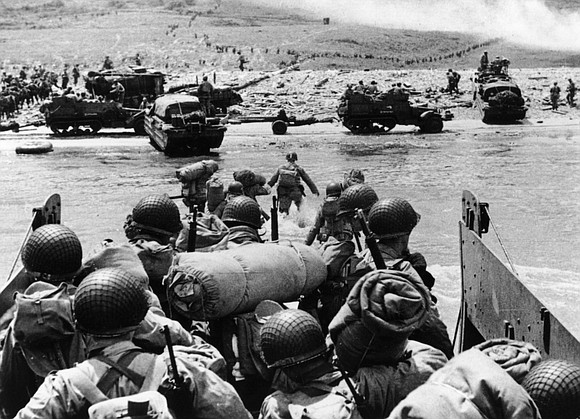How the moon played a crucial role during the D-Day invasion
CNN/Stylemagazine.com Newswire | 6/6/2019, 8:26 a.m.

By Ashley Strickland, CNN
(CNN) -- The D-Day allied invasion of Normandy began with paratroopers and soldiers coasting through the air on gliders in the darkness of the early morning hours. And a full moon lit the way.
They landed on the beach first, captured coastal bridges and opened roadways for the incoming fleet carrying troops.
Many historical accounts cite the importance of a late-rising moon in making the airborne assault successful, allowing for secrecy.
However, Texas State University astronomer Donald Olson says these accounts are incorrect and the moon rose early that fateful day. The description of a late-rising moon was counter to statements from General Dwight D. Eisenhower and Prime Minister Winston Churchill. The Allied leaders noted the full moon as key to guiding the way of each stage of the assault between June 5 and 6.
And Olson realized that a late-rising moon didn't match the tide during the invasion. When he used astronomical software, Olson saw that the moon rose early that day.
"It's not a late-rising Moon. The Moon actually rose before sunset on June 5 and remained in the sky all night long," Olson said. "It didn't set until after sunrise. It was reaching the highest point in the sky at 1:19 a.m., near the time of the British Pegasus Bridge assault and just as the American airborne operations began."
He was able to trace the error back to its original source.
"Why do so many authors use the same phrase, 'a late-rising Moon?' They're all following Cornelius Ryan, who wrote that in his book, 'The Longest Day,' " Olson said. "It's pretty clear that he's the one who spread it, but he's not the one who said it first. I traced it back to Walter Bedell Smith."
Smith was Eisenhower's chief of staff between 1942 and 1945. After the war, Smith wrote a series of articles for the Saturday Evening Post describing the motivations behind the actions of the Allies during the war.
Smith wrote, "For the airborne landings ... we needed a late-rising full Moon, so the pilots could approach their objectives in darkness, but have moonlight to pick out the drop zones."
In fact, those who planned the invasion had clear requirements: plentiful moonlight over the course of the entire evening and a low tide near sunrise.
Given the position of the sun and moon in relation to the Earth, which determines the strength and time of the tide, as well as when that tide would occur on this specific part of the Normandy coast, a full or new moon was required. In order for it to occur during the full moon, the Allies had their pick of June 5, 6 or 7.
None of these evenings had a late-rising moon.
"A spring invasion in May or June was ideal, because that would leave the entire summer for the Allied forces to drive back the German forces before bad weather set in with the coming of fall and winter," Olson said. "Invasion preparations weren't complete by May, so General Dwight D. Eisenhower postponed the assault until June.
"The Allies wanted low water so they could blow up the German's beach obstacles, but they also wanted rising water so that they could beach a craft and not get stranded," Olson explained.
"If they landed on a falling tide, the landing craft would be stuck there for as much as the 12 hours. That's an important part of the D-Day plan -- rising water, just after low tide."
They landed at low tide, but it would begin rising soon -- and quickly.
Unfortunately, the timing of the tide was a challenge for the the Allies in another way. On the beach during landing, there was a 19-foot difference between low and high tide. During low tide, the normally underwater beach obstacles placed by the Germans were exposed and could be destroyed.
But there was only about 30 minutes before the tide rose, and the demolition teams had to operate much quicker than they expected while under enemy fire on Omaha Beach.
At 7 a.m., the tide was rising 1 foot every 10 minutes and surging, so the demolition teams could only clear five of the obstacles rather than the 16 they initially planned. The remaining beach obstacles, which could tear destructive holes in ships or explode on impact, succeeded in their design of taking Allied lives. Later, the beach would be known as "Bloody Omaha."





